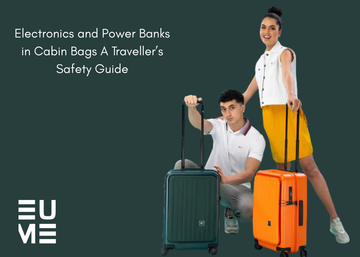Have you ever been stopped at airport security, forced to hand over a power bank because it didn’t meet the rules? Travellers around the world face this every day, often because of unclear airline policies on electronic items cabin baggage.
The Global Power Bank Market size is expected to be worth around USD 35.2 Billion by 2034, from USD 15.7 Billion in 2024, growing at a CAGR of 8.4% during the forecast period from 2025 to 2034, proving how essential these devices are for modern travellers. Yet lithium battery incidents on aircraft have risen 42% in five years, which explains why aviation authorities enforce strict rules. Knowing whether is power bank allowed in cabin bag isn’t just about compliance it’s about passenger safety and peace of mind.
EUME has stepped in with accessories designed to meet these exact requirements. Their travel new collection Triumph Collection which has Eume ON THE GO type A and Type C charging ports powered by your power bank and secured with a combination lock, keeping you connected while travelling, so passengers stay connected without breaking regulations.
Is Power Bank Allowed in Cabin Bag Under Current Regulations
Asking is power bank allowed in cabin bag comes with a conditional answer. Most airlines allow power banks in cabin baggage but ban them from checked luggage. The reason is simple: fire risk.
Why Airlines Regulate Power Banks
Lithium-ion batteries can overheat and catch fire. In a cargo hold, crew can’t intervene quickly, so the danger escalates. The FAA has logged more than 340 lithium battery incidents since 2006, some serious enough to force emergency landings. That’s why IATA created guidelines that airlines worldwide now follow.
Cabin vs Checked Baggage Rules
Power banks must go in your cabin bag. Crew can respond instantly to any thermal issue there. Under electronic items cabin baggage rules:
-
Power banks under 100Wh are allowed in cabin bags without special approva
-
Batteries between 100–160Wh may require airline permission
-
Anything above 160Wh is banned from passenger aircraft
What Electronic Items Cabin Baggage Rules Allow
Knowing which electronics are permitted helps you pack correctly and avoid last-minute stress.
|
Device |
Cabin Baggage |
Checked Baggage |
Special Rules |
|---|---|---|---|
|
Power Banks |
Allowed with limits |
Prohibited |
Must be under 100Wh or get approval |
|
Laptops |
Allowed |
Allowed |
Remove during security screening |
|
Tablets |
Allowed |
Allowed |
Keep accessible |
|
Cameras |
Allowed |
Allowed |
Spare batteries in cabin only |
|
E-Readers |
Allowed |
Allowed |
No extra rules |
Devices You Can Bring On Board
Smartphones, laptops, tablets, cameras, and e-readers are all allowed in cabin bags. The main restriction applies to spare batteries and power banks, which always need to stay in carry-on bags with terminals covered.
Security Screening Tips
Airport screening can be smoother with a little preparation.
-
Keep laptops and larger electronics outside your bag for scanning
-
Place power banks where security staff can clearly see the capacity markings
-
Use cable organisers to avoid tangled wires that slow inspection
How TSA Electronics Rules Apply Internationally
TSA electronics rules form the backbone for global aviation policies, but each country may add extra restrictions. Having clarity here prevents delays and confiscations abroad.
IATA Lithium-Ion Regulations
-
IATA’s guidelines set the worldwide baseline
-
Power banks up to 100Wh (about 27,000mAh at 3.7V) are fine without approva
-
100–160Wh units may be carried only with airline permissio
-
Above 160Wh is prohibited on passenger flights
Individual airlines may still impose stricter limits, so checking before departure is essential.
mAh Limits by Airline
Different carriers treat the same rule differently.
-
Most European airlines hold firmly to 100Wh limit
-
Some Asian airlines allow higher capacity but only with prior approva
-
Budget airlines often enforce stricter caps to minimise delay
-
Premium carriers may allow flexibility for business travellers but don’t compromise on safety
Best Ways to Pack Electronic Items Cabin Baggage Safely
Packing electronics properly is just as important as knowing the rules.
Cable Organisers and Protective Storage
-
Keep cables in organisers to prevent short circuits
-
Cover battery terminals with tape or caps to avoid accidental contac
-
Place power banks in accessible compartments so they can be screened easily
Avoiding Common Packing Mistakes
-
Never place power banks in checked luggage, regardless of size
-
Avoid packing damaged batteries or devices under recall notices
-
Spread multiple power banks or batteries across bags if travelling in a group to minimise risk
Which Power Banks Are Allowed in Cabin Bag
Modern power banks come with advanced features, but the same rules apply.
Wireless and Fast-Charging Models
Wireless and fast-charging features don’t change regulations. What matters is capacity. High-powered laptop chargers often approach the 100Wh mark, so always check watt-hour ratings rather than marketing terms.
Solar and Hybrid Devices
Solar power banks are acceptable if the lithium capacity stays within airline limits. Solar panels themselves don’t affect compliance, but the device can’t be used mid-flight. Hybrid devices combining multiple functions must be assessed based on total lithium content.
How EUME Makes Electronics Travel Safer
EUME designs travel kits that meet international aviation safety requirements. Their accessory sets include fire-resistant pouches, clear capacity markings, and quick-charge-ready designs. These features make it easy to comply with TSA electronics rules and airline-specific policies.
Their focus on practical design means travellers can carry essential devices confidently without risking confiscation or penalties.
Conclusion
Knowing the answer to is power bank allowed in cabin bag and following electronic items cabin baggage rules means fewer headaches at security. With clear preparation, travellers can stay powered up without worrying about confiscation or delays.
The key is compliance and organisation: pick power banks within safe capacity, pack electronics in accessible areas, and check your airline’s specific limits before flying. With the right gear, your devices travel safely alongside you.
Ready to fly without worry? Check out EUME’s compliance-approved accessory kits designed to keep electronics safe, accessible, and within regulations.
FAQs
Why are power banks banned in checked bags?
Lithium batteries can overheat and cause fires. Cargo holds can’t be monitored in-flight, so power banks must always stay in cabin bags.
How many mAh power bank is allowed on IndiGo?
IndiGo follows IATA standards, permitting power banks up to 100Wh (around 27,000mAh). Between 100–160Wh needs airline approval. Over 160Wh is not allowed.
Do airlines scan for lithium batteries in cabin bags?
Yes. Security scanners detect battery shapes and densities, and staff are trained to identify unsafe or damaged batteries.
Can I carry multiple power banks on one flight?
Usually yes, but some airlines limit numbers even if capacity is under 100Wh. Splitting them across bags with companions helps avoid issues.
Are wireless or solar power banks treated differently?
No. Regulations focus only on lithium capacity. Wireless charging or solar panels don’t affect approval.























